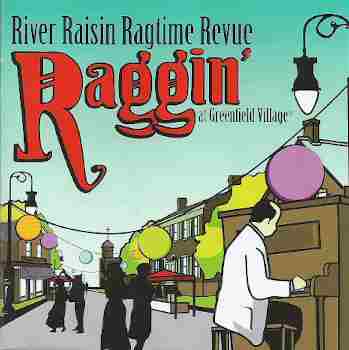
River Raisin Ragtime Revue. Raggin’ at Greenfield Village. www.ragtimeband.org Recorded June 4-5, 2011.
William Pemberton, tuba and director; William King, clarinet; Catherine McMichael, piano; Rod McDonald, banjo; Clark Irwin and Kiri Tollaksen, cornet; Saura Wyman Pemberton, flute; Barbara Sturgis-Everett and Priscilla Johnson, violin; George Thompson, trombone; Alison Badger, cello; Andre Dowell, percussion; Susan Schreiber, viola.
The River Raisin Ragtime Revue under the direction of tuba player William Pemberton, has produced a wonderful recording of 21 arrangements that span the period from pre-jazz music right through to compositions of some of the truly great in jazz. It is fascinating to hear the early works that just hint at jazz but are still firmly entrenched in late nineteenth-century dance music. Works that fit this category include “Mississippi Rag: Two-Step” (1897) by W.H. Krell, “Virginia Diggins” (1915) by Tom Turpin, “Walkin’ the Dog: Fox Trot” (1916) by Brooks and Shrigley, and “Selections from Clorindy” (1899) by Will Marion Cook. Rags from the end of the nineteenth century and first decade of the twentieth century have their own solidly identifiable quality which also have one foot in the dance and march world but hint at the new music that is soon to come.
An early work that more than just hints at the jazz style is “Castle House Rag” (1914) by James Reese Europe. Gunther Schuller wrote a spectacular arrangement of this work and the rhythmic vitality of the piece is very much in the spirit of jazz. It is interesting to note how early some of the works of the great stride piano players were composed. Stride piano, of course, is distinguished from rag-time in a number of ways, most importantly in that stride was typically improvised or, at least not notated like ragtime was. Lucky Roberts’s “Pork and Beans” (1913) and James P. Johnson’s classic “Carolina Shout” (1918) are examples of two early pieces that are clearly jazz but written at a time when the new jazz style was still not yet fully developed. We tend to regard stride piano as a style of the 1920s and 1930s, and it clearly was, but history is never as clear cut as the history books might indicate. The first two decades of the twentieth century were a period of intense change as well as one active with a wide range of musical styles. “Carolina Shout” (1918), Jelly Roll Morton’s “Original Jelly Roll Blues” (1915), Scott Joplin’s “Gladiolus Rag,” and “Virginia Diggins” (1915) by Wilbur Sweatman are four compositions all written within a few years of each other that represent wildly divergent styles.
The arrangements of those four tunes are wonderfully performed by the River Raisin Ragtime Revue, as are all the cuts on this fascinating recording. Of special note is Clark Irwin’s cornet playing, particularly on the Kit Johnson arrangement of Fats Waller’s “Black and Blue” (1929) and a wonderful arrangement by Chuck Israel of the “Potato Head Blues” (1927). This CD beautifully demonstrates the different styles of popular music during a short period of time at the beginning of the last century. While the styles are diverse, they all share a common thread of being part of the jazz tradition or one of the roots that would soon develop into that art form.
-- Jeffrey Nussbaum



